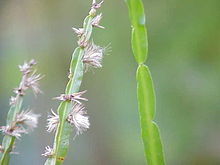Baccharis genistelloides
| Baccharis genistelloides | |
|---|---|

| |
| Scientific classification | |
| Kingdom: | Plantae |
| Clade: | Tracheophytes |
| Clade: | Angiosperms |
| Clade: | Eudicots |
| Clade: | Asterids |
| Order: | Asterales |
| Family: | Asteraceae |
| Genus: | Baccharis |
| Species: | B. genistelloides
|
| Binomial name | |
| Baccharis genistelloides (Lam.) Pers.
| |
Baccharis genistelloides is a species of plant from the family Asteraceae.[1] B. genistelloides is one of the most studied species in the genus Baccharis regarding its phytochemistry and pharmacological effects.[2] The plant species is widely used in folk medicine.[3]
The plant has been used to treat high blood pressure, diabetes, stomachaches, and kidney infections.[4] The plant also contains flavonoids that make it have anti-inflammatory properties.[5]
The plant is perennial.[6]: 42
The species along with almost all Baccharis species is dioecious.[7] With the flowers on this plant being unisexual.[1]
It is found in countries like Peru, Bolivia, Chile,[8] Brazil,[9] Colombia, Ecuador,[10] Paraguay, and Uruguay.[11]
Common names[]
In Andean communities it is locally known as quina senqa.[12]: 27
In Portuguese it goes by the common name carque, bacante, and carqueja.[1]
References[]
- ^ a b c "Baccharis genistelloides (Lam.) Pers. - Encyclopedia of Life". eol.org. Retrieved 2021-09-09.
- ^ Máthé, Ákos; Bandoni, Arnaldo (2021-04-15). Medicinal and Aromatic Plants of South America Vol. 2: Argentina, Chile and Uruguay. Springer Nature. p. 88. ISBN 978-3-030-62818-5.
- ^ Riet-Correa, Franklin (2011). Poisoning by Plants, Mycotoxins, and Related Toxins. CABI. p. 713. ISBN 978-1-84593-833-8.
- ^ Paniagua-Zambrana, Narel Y.; Bussmann, Rainer W.; Romero, Carolina; Echeverría, Javier (2020), Paniagua-Zambrana, Narel Y.; Bussmann, Rainer W. (eds.), "Baccharis genistelloides (Lam.) Pers. Asteraceae", Ethnobotany of the Andes, Ethnobotany of Mountain Regions, Cham: Springer International Publishing, pp. 291–296, doi:10.1007/978-3-030-28933-1_304, ISBN 978-3-030-28933-1, S2CID 240781469, retrieved 2021-09-09
- ^ Albuquerque, Ulysses Paulino; Patil, Umesh; Máthé, Ákos (2018-10-24). Medicinal and Aromatic Plants of South America: Brazil. Springer. pp. 27–28. ISBN 978-94-024-1552-0.
- ^ Watson, Ronald Ross; Preedy, Victor R. (2008). Botanical Medicine in Clinical Practice. CABI. ISBN 978-1-84593-413-2.
- ^ Fernandes, Geraldo Wilson; Santos, Jean Carlos (2014-06-26). Neotropical Insect Galls. Springer. p. 195. ISBN 978-94-017-8783-3.
- ^ Heim, Edgar (2014-12-01). Flora of Arequipa, Peru: A Field Guide for Nature Lovers. BoD – Books on Demand. p. 32. ISBN 978-3-7347-3299-7.
- ^ Granulocytes: Advances in Research and Application: 2011 Edition. ScholarlyEditions. 2012-01-09. p. 83. ISBN 978-1-4649-2293-0.
- ^ "Baccharis genistelloides (Lam.) Pers. | Plants of the World Online | Kew Science". Plants of the World Online. Retrieved 2021-10-25.
- ^ "Tropicos | Name - Baccharis trimera (Less.) DC". legacy.tropicos.org. Retrieved 2021-10-25.
- ^ Walker, Barry; Cheshire, Gerard; Lloyd, Huw (2007). Peruvian Wildlife: A Visitor's Guide to the Central Andes. Bradt Travel Guides. ISBN 978-1-84162-167-8.
- Baccharis